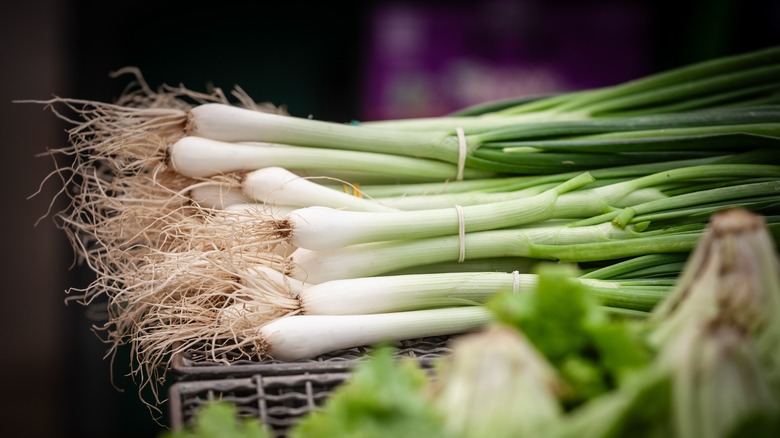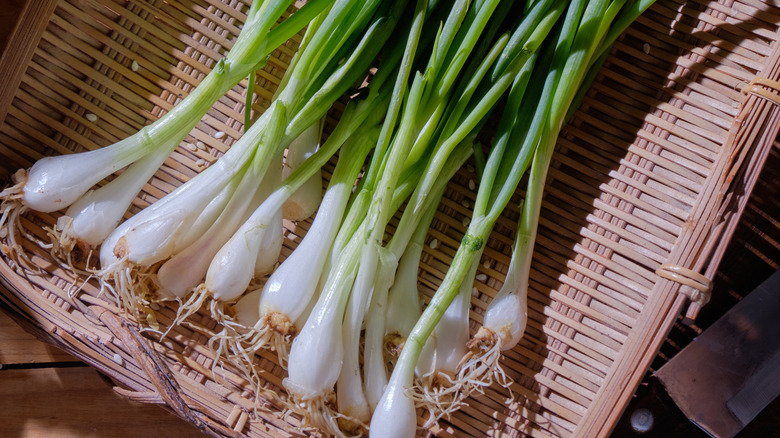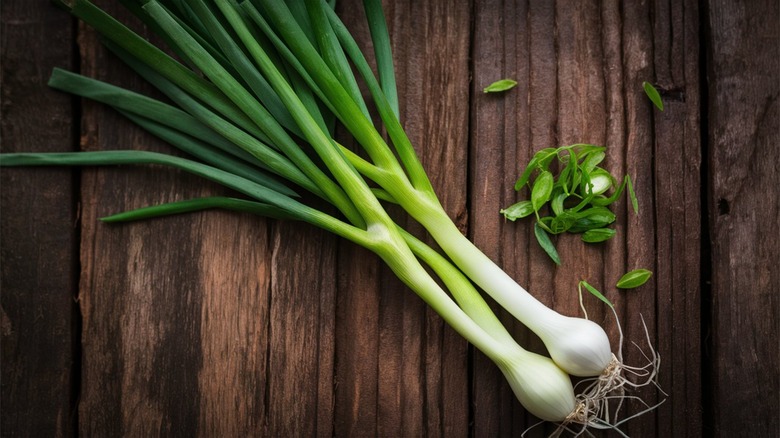Yes, The White And Green Sections Of Scallions Have Different Uses
Have questions about using scallions, but were never quite sure how to ask? We've got you covered and before you get started with utilizing them in your dishes, you should know that there are different uses for the white and green sections of the scallion — and they should be treated differently in the kitchen. First, let's clarify something: Spring onions, garlic scapes, and ramps are different, but if you see something labeled "green onions," that's just a different name for a scallion. Green garlic? That might be a scallion look-alike, but it's not the same thing, and while scallions might look like small leeks, they're different, too.
Scallions are edible from tip to tip, and if you love onions, they're delicious when eaten right out of the fridge. If you're using them as an ingredient, though, a good general guideline to keep in mind is that if a recipe just calls for scallions to be included in the cooking process but doesn't specify which part, the default is generally the white part.
However, if you're reading an equally vague recipe that calls for using scallions as a garnish, it's going to be referring to the green part. The white and green parts have very different flavor profiles and behave differently when they're cooked, but fortunately, those differences are very easy to remember.
The white section of a scallion is the onion-y part
It's easy to remember the guidelines for using the white part of the scallion: This is the section that looks more like a young onion, and that's precisely what flavor you're going to be getting. Although they don't need to be cooked as long as a standard onion, recipes that call for them usually do so with the expectation that they're going to be a part of the cooking process.
Don't worry about getting things exact, though: There's no definite dividing line between the sections, so if there's a little green in the white that you've chopped and prepped for the frying pan, that's fine! If you are, however, cooking the entire scallion, you can choose to add the white sections first — the delicate greens don't need as much time to cook.
There's one more thing to keep in mind about the white section, and specifically, it's the roots that are important here. If you use scallions a lot, you might want to consider growing them in your kitchen. Select scallions with long, healthy roots, and chop them above where they're just starting to transition into green. Put them in a small glass with water covering most of the white part, and they'll start to re-grow. In just around a week, you'll have green sections ready to go. Change the water every few days, and they'll grow indefinitely.
The green sections make excellent garnishes
The green section of the scallion is also edible, but it has a completely different flavor profile. If you're familiar with chives, it's similar — and can be used for many of the same applications. Add slices to the top of baked potatoes, to your favorite mayo-based macaroni or potato salad, or sprinkle on top of an omelet to add a mild, herbaceous flavor and a delightful crunch. As previously stated, there is no definite rule for separating the two sections, but generally speaking, the green section is going to be hollow.
The green stalks are also a great indicator of how fresh your scallion is. If you're shopping for scallions and find some with greens that appear to be soft or starting to wilt, or if they have a slimy texture, skip that bunch and choose one where the stalks are firmer. Freezing scallions isn't recommended and you'll want to use them when they're all their freshest, so keep an eye on those green parts as a way to gauge freshness. Store scallions in a jar in the fridge, filled with enough water to ensure that about two inches of the white is covered. They'll last for about a week, and if the tips of the green stalks start to wither, cut, discard, and use the rest ASAP.


